Software Review (kind of): Fantasy Map Making with Hexographer
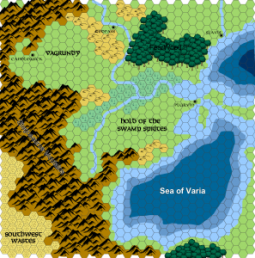
I dare say that we Black Gate types love maps and charts of imaginary lands.
As kids, we pored over the maps in CS Lewis’s Narnia books or Tolkien’s The Hobbit. Most of us have had posters of Middle Earth or the Hyperborian Age on our walls and almost all of us have scratched out maps of imaginary places, either for the joy of it or as a DM/GM or Fantasy writer.
It’s great fun to draw a map using pencil and paper. However, there are practical limitations. It’s hard to make changes neatly, difficult to produce different versions of the same map, a fiddle to create small scale local maps, and ultimately a chore to curate all the bits of paper.
For most of us, digital is our friend, which is why I am reviewing Hexographer, a relatively inexpensive Fantasy map making tool.
Hexographer very much has its roots in old-school roleplaying.
It began as a tool for creating Mystara-style maps and cheerfully emulates the World of Greyhawk feel. However, with a range of symbol sets to choose from, it’s grown into a flexible Fantasy cartography tool. What makes it distinct is that it explicitly treats maps as collections of hexagons (though you can place items freehand as well), which makes it almost perfect for writers and gamers.
However, first let’s get the business of pretty maps out of the way…
Hexographer as cartographical graphic design tool
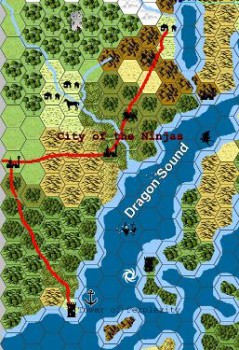
Most Fantasy cartography packages are really “cartographical graphic design tools.”
They make the pretty maps that go out in the front of a Fantasy novel, or are packaged up with an RPG campaign or scenario.
Hexographer can produce pretty maps, as long as you don’t mind them on hexagons. This is no good for your self-published Sword and Sorcery novel, but fine to hand on to a designer hired by your publisher. Obviously, this is more than fine for a roleplaying campaign, though with fewer design options than on offer from much much more expensive packages.
EDIT: JUST DISCOVERED THAT YOU CAN SWITCH OFF THE HEXAGONS
Beyond that is a matter of taste, though I think the clarity of Hexographer maps has its own aesthetic value.
(I should also mention that Hexographer can handle city and settlement maps, with symbols for towers and walls and so on, and also Traveller-style hex-space maps. )
However, as a writer and gamer, I am not really interested in squandering time on producing pretty maps, except perhaps at the very end of the creative process. Instead, I am interested in…
Hexographer as cartographical creativity aid
During the creative process, a map is both where you discover stories and where you choreograph and timetable them: “That lake is in an interesting spot, suppose a dragon lives there. The characters need to cross a river. I’ll put a river…. there. Now how long will it take them to carry the wounded elf back to the city?”
So we writers and GMs need map making software that works as a “cartographical creativity aid”. This is where Hexographer excels and looks to be on the way to becoming the mapping equivalent of Scrivener.
Inspiring and Easy-to-use
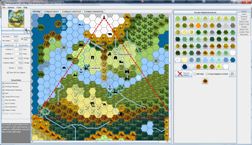
Assuming that the resulting maps look good enough to be inspiring, the basic requirement of a cartographical creativity aid is that it should be as easy-to-use as a word processor. We want to work “in flow,” creating and revising without fiddling about or needing to stop off to swear at the interface and trawl a badly written user manual.
Though it has one or two eccentricities, Hexographer easily passes both these tests. The maps look nice, and after an hour of tinkering, I was scrawling away merrily, creating continents and islands and peopling them with my imagination. It was like being six years old, making a castle-strewn landscape on the beach.
Eventually, I noticed “missing features.” For example, you can only have one map open at a time and there’s no capacity for selecting chunks of the map and then rotating or cutting and pasting them (I am told this is coming). However, Hexographer is still much more usable than most similar packages.
Beyond that, I think there are four interrelated requirements: spherical worlds, qualitative landscape, vague details, and child maps.
Spherical Worlds

The Earth and most Fantasy worlds are… (drum roll) round. Flattening out bits creates distortions, e.g. I have a map of the Crusades in which the British Isles look as large as Asia Minor, and a Viking Age map where Greenland looks like its own continent.
The ideal cartographical creativity aid would be like Google Earth, and simply present you with an animated globe on which to work. This, alas, does not exist. True, there are at least two packages that do let you create terrain on a globe, but neither support the addition of human features and text and both violate the easy-to-use requirement by providing insufficient control over the creation of landmasses and/or having insanely complicated tools.
Like most of its rivals, Hexographer handles spherical worlds by offering a Icosahedral (Traveller-style) template that looks a bit like an exploded D20 (because it treats the world as a polyhedron). This still creates distortions, but none that really matter because stories and RPGs deal in distances like “three days journey north” rather than “162.3 km North by North East.”
Hexographer has a slight advantage over its rivals here because it works directly in hexagons, making it very easy just to splash on terrain and features without having to nit-pick over edges. It also offers a free tool for randomly generating an Icosahedral map.
Qualitative Landscape
Stories and roleplaying games mostly perceive the environment in terms of qualities (“Massive mountain range over there!“) rather than quantities (“Look, a range of mountains reaching up to 9000m!“). Lovingly drawn contour lines and standard realworld cartographic symbols don’t actually convey this information very well. Textures such as “badlands”, for example, may not show up on large scale maps, and it’s hard to tell at a glance whether elevated geography is crinkly spiky mountains or rolling hills. It follows that little sketches of terrain features — symbols — are actually more useful than the “proper” alternative.
Compared to its rivals, Hexographer offers a slightly limited range of symbols, but makes up for it in two ways. First, the symbols are all systematically useful, e.g. “Evergreen Mountains”, “Dead Forest Mountains”, “Badlands “. Second, and more importantly, the symbols slot neatly into hexagons, making it very easy indeed to use them. (With other tools, you can end up having to fiddle to layer mountain ranges on top of each other, etc.)
Vague Details and Child Maps
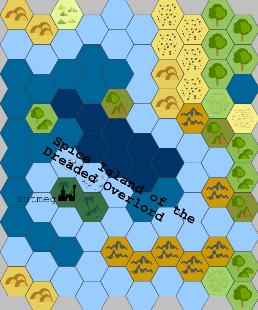
This may seem like an odd requirement, but most writers and GMs really don’t want to commit to specific details until the last possible moment.
For example, say I place an island on the other side of the world from my main theatre of operations. It’s probably enough to write, “Spice Island of the Dreaded Overlord”, note that it’s mountainous, and then mark the capital city. Anything more is both a waste of time and also psychologically limiting. When the story or party of adventurers reaches the island, then I’ll know exactly what kind of place it is, and not before.
In other words, I don’t really want fractal lines and precise locations. I want my maps to have vague details until I decide otherwise.
Because it deals in hexagons, Hexographer lends itself wonderfully to this approach. My Spice Island of the Dreaded Overlord appears on my world map as just two hexagons, both with jungle mountains, plus the capital city, Nutmeg.
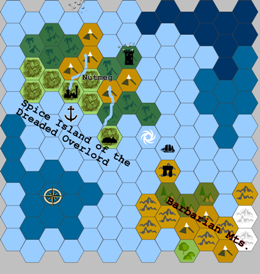
It follows that when I do decide to nail down the details, I want to be able to produce a child map, that is, a larger scale map of a smaller area.
Bizarrely, all the other software I’ve tried simply doesn’t handle this well. Cartographer, for example, won’t snip all those fractal land masses and other features. You have to either turn it into ordinary pictures, or else resize and retrace your section pretty much as if you were working with paper and a light box.
Hexographer, however, creates child maps with consistent ease: select your area, specify a new scale, and bang! there’s your child map ready for you to tinker with the details.
Trivial though this sounds, for a cartographical creativity aid, easy child maps are an absolute killer feature. There’s a lot to like about Hexographer, and a few things to put up with, but this feature alone is enough to make me abandon other packages.
Hexographer: Summing up
From the writer/GM perspective, if Hexographer is not quite the Holy Grail — to achieve that status, it would need to specifically handle spherical worlds — it has the advantage of actually existing and being extremely good value for the money. (You can also try it out for free.)
However, it reminds me a bit of the early versions of Scrivener for Windows; there’s a lot of room for enhancement and a sense that this will come. However, as it stands, it’s a really good — what did I call it? — Cartographical Creativity Aid and great fun to use. It’s certainly what I’m using to world build for my next Fantasy novel…
M Harold Page (www.mharoldpage.com) is a Scottish-based writer and swordsman. His historical adventure yarns are all available on Amazon and he is currently working on a take if Heroic Fantasy. Watch this space!
Wow it’s odd that you post about this. I’ve been looking to start making a sandbox game for my RPG group.
Having looked at several modules I can’t find anything I really like so I ll have to make it myself.
What I want to do is make the map ahead of time and give the players a blank version to discover and fill in themselves. I will check this out as soon as I have time.
I really enjoyed the article by the way. Very well written.
Very, very tempting — I’ve tried Campaign Cartographer a few times over the years, but while I respect (and fear) it, I’ve never been able to give it the time it deserves.
Now THIS, on the other hand, perhaps in conjunction with my treasured TSR World Builder’s Guidebook …
@glen: It does offer the ability to switch stuff on and off so you can hide what the players shouldn’t see.
@Joe H: I have Campaign cartographer, and though it looks awesome, all it’s done for me is eat hours of time I could have used writing.
As a fantasy writer with no drawing ability (my stick figures look like a random collection of lines) this program looks like it could be extremely useful. Thanks for calling it to my attention.
> Thanks for calling it to my attention.
I must confess an element of self interest here. The more people buy this tool, the more effort the developer will put into it!
This DOES look cool.
I’ve played around enough with Campaign Cartographer that I’ve figured out to make it behave, but I work on a Mac now and can’t figure out how to mess with Bootcamp to make it work on my new computer… this just looks pretty cool, especially since I’m wanting to do something like Glenn is contemplating. Maybe I’ll pick it up myself.
Thanks for letting us know about it!
[…] See the full review here. […]
Has anyone tried the dungeon creater program? I’m equally curious about that one.
Also I think that’s an excellent point that, as an author or a GM, you don’t need USGS cartographic precision — you’re more interested in the river that flows from the mountains through the forest to the sea, the cities along the river, the desert on the far side of the mountains, etc.
(And I’ve certainly seen my share of in-book maps — the Dragonlance novels, e.g. — that were clearly taken from a hex-based original.)
Glenn – Has anyone tried the dungeon creater program?
I have used Dungeonographer, as with hexogrpaher it’s super quick to learn and start getting ideas out of your head and onto a page. Which, for me at least, is the most important feature of all of my cartographic software. Also, as with hexographer, try the free version and see what you think. I have all three of Inkwell Idea’s mapping packages – hex, dungeon and city. There super fast, well priced and very user configurable.
Just to note: I’ve also been using Campaign Cartographer for just over 15 years as well as just about every other mapping software out there – NBos FM, fantasygrounds,dundjinni, dungeon forge, and of course Illustrator/Photoshop – and while they all have uses, Inkwell’s Trio gets more use during writing and playing then all the others.
There doesn’t seem to be that much of a price difference between campaign cartographer and hexographer.
If you buy the main three world, dungeon, and city map creators campaign cartography is only $8 more than Hexographer
@Glen – the prices seem to vary!
Ultimately, given the time investment, the difference in price is trivial; a few beers.
However, when I checked right now:
The Profantasy bundle is USD 99 (down from USD 124)
The similar Hexographer bundle is USD 79 (down from USD 95)
So at the moment there’s USD 20 in it.
Bought on their own:
CC3 is USD 44.95
Hexographer is USD 31.95
That’s a difference of USD 13.
I’ve been thinking for a long time about getting something like this. It sounds like Hexographer is the just what I’ve been hoping to find. Thanks!
[…] Like most writers, I am used to creating by iteration. I rough things out then refine them, tinkering with structure and detail until things are right. That’s how I write, and how I want to worldbuild. […]
I’m late to this post, but I’m planning out a campaign for 5e and was doing some searching about here on Black Gate and saw this review. I’ve previously heard of Hexographer. It looks pretty good. Just curious since this review was written in 2014 if Hexographer is still the easiest map software out there for RPG campaign map-making? I hope someone still reads comments on older posts so I’m not just talking to the virtual ether.
I do go looking from time to time, and haven’t found anything easier.
Thanks M Harold Page for the original review and the quick update in your comment!
I’ve just started using Hexographer, and I love it! I bought Fractal Mapper 8.0, and it is incredible, but it is also very complex to learn, and use.
I really wanted to create digital, professional versions of my hand-drawn maps, from 1988, for my current D&D games, but Fractal Mapper just has no way to import, and copy, hand-drawn maps… However, Hexographer does!
I took a photo of my old maps, converted the image to a PNG format, imported it as the background, with opacity set to what the instructions recommended, and then within an hour, I had my digital version 80% complete — only the text names of places, and features, and cities, needs to be added yet.
I created a hand-drawn, isometric map of my game world many years ago, but I had to color it by hand… I never finished it. Now, I can put together a superb map, on the computer, and it will look even better.
Don’t forget, Hexographer exports your maps as PNG files. The PNG files can be enlarged with minimal pixellation, so make your world maps, and then send them to someplace like http://www.bannersonthecheap.com, to get them made into a 3-foot by 5-foot vinyl banner, to really have some fun! Cheers!
Thanks for sharing! And thanks for the tip.